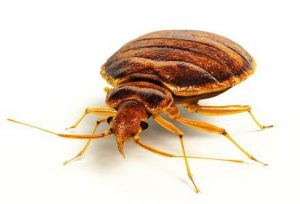Bedbugs

Did you Know Bedbugs can ingest 7times their body weight in blood?

BEDBUGS
Adult bedbugs are usually 4-5 mm long, rusty red-brown coloured, wingless and oval-shaped. Bedbugs do not fly, but they can move quickly over floors, walls, and ceilings. Body shape is normally quite flattened, but it can be rather expanded and ovoid after a blood meal. Adults may live for over a year. They can survive several months without a blood meal. A female may lay 200-500 eggs in her lifetime. Eggs usually hatch in 7-30 days, and the nymphs must have at least one blood meal between moults. Typically, bedbug nymphs undergo about five moults before reaching adulthood.

Bedbugs as pests
Bedbugs are ectoparasites of animals. Their most important host is humans, but in some cases bats, cats and other animals may serve for feeding. They are bloodsucker. The adult female must have a blood meal for protein before egg laying. Eggs in batches of up to ten or more are cemented to surfaces of hiding places close to the host’s sleeping area. Bedbugs hide in cracks and crevices in fairly close proximity to the bed during daylight hours. In the dark time when the host comes to bed, the warmth and CO2 of the host’s body provoke them to locate the feeding site. After the meal, they return to their hiding places, where they are somewhat gregarious and may be found closely grouped together.
When the bedbug bites its victim, saliva with anticoagulant properties is injected via piercing and sucking mouthpart to increase blood flow of the host. They have a tendency to test bite, which often results in a line of bites. For some people, the bite is painless and there is no allergic reaction. However, many people react with local swelling at the site of the bites, followed by mild to severe itching and irritation.
Bedbugs disperse largely by being carried by humans in furniture, luggage and clothing. Bed bugs infestations are increasing rapidly in most part of the world including Australia. They are mainly associated with the sleeping quarters of hotels, motels, taverns, inns, backpacker and student accommodations, and other dormitory-type facilities. In domestic residences, any infestation is usually centred on the bedrooms.
In infested premises, evidence of activity can include: blood spots on the sheets, small dark-brown excreta marks on the sheets, live bugs hiding in cracks and crevices in furniture, behind skirting, among books, behind wallpapers, in bedding and mattress, bed frame, eggs cemented to similar surfaces, cast skins and in the case of heavy infestation, a sickly sweet buggy odour. This odour is caused by bugs ‘body secretions.
Housekeeping Preventative Measures & Control Tips
Prevention is always the best defence. So, getting in the good habits of hygiene practice and regular inspection of bedroom, furniture, luggage and clothing will help to keep the bedbugs away from dwelling areas. Thoroughness in housekeeping will make the rooms less favourable for bedbug infestation.
- Regularly wash and heat-dry your bed sheets, blankets, bedspreads and any clothing that touches the floor.
- Keep your home clean. Vacuum the carpet and soft furniture regularly. Remove the clothes, toys, papers and other clutter from the floor.
- Never put the luggage, suitcase, backpack, shopping bags, purse or any other bags on your beds because these items are the most common stuff via which bedbugs travel from one place to another.
- Don’t pick up furniture, mattresses, bedding or clothing that have been left on the street or in a dumpster.
- Clean second hand furniture outdoors and do a thorough inspection when you buy it. Be sure to remove all drawers before cleaning, inspect all crevices, and clean underneath the item, too.
- Avoid the cardboard boxes from behind the liquor stores or shopping centres when moving. Instead, you can buy your own bedbug-free boxes from packaging supply stores.
- Get rid of bats and birds that may be living in your attic or roof void. Bats and birds may introduce bedbugs, ticks, flea, mites and other bugs to your home. This service is specifically available by our BUGZOFF experts on treatment day as part of an integrated pest management program.
- Repair cracks and crevices in walls, ceilings and floors, and glue down peeling wallpapers to reduce bedbugs’ harbourage areas. This service maybe offered by our BUGZOFF experts on or after treatment day.
Housekeeper’s Pre-treatment Cooperation
A thorough clean-up prior to insecticide application is of most importance and can be most beneficial which may be done either by householder or our BUGZOFF experts. Before doing any clean-up, you have to put on disposal booties over your shoes and wear disposal gloves. In massive infestations you may need to wear disposal overalls as well. After cleaning you must put them in a sealed plastic bag and throw it away in the garbage bin outside of the home. Just keep in your mind if you fail this pre-treatment clean-up process, you may play the role of transporter for the bugs and you will facilitate their travel from one place of the home to another spot which may lead to reinfestation and poor treatment. That’s why we highly recommend to leave this specific pre-treatment process to our professional experts for peace of mind.
- Vacuum bedbugs on your bedding, linens, blankets and surrounding areas.
- Put linens, bed sheets, pillow covers, blankets, skirting and curtains in sealed plastic bags to carry them to laundry.
- Wash clothing, curtains, linens, bed sheets, pillow cowers, blankets and skirting in hot water and dry them on the highest dryer setting.
- Use a stiff brush to scrub mattress seams to remove bedbugs and their cemented eggs before vacuuming.
- Take the vacuum cleaner outdoors, empty the vacuum contents immediately in a sealed plastic bag and throw it away in the garbage bin.
- Use a steamer to kill any remaining bedbugs and destroy any remaining eggs in the bedding and carpet area. This service maybe offered by our BUGZOFF experts on treatment day.
- Any potential sources of reinfestation must be kept at home when treatment is carried out. For example, if a child has been taken out in a pram or stroller while the room is being treated, any bugs hiding in the joints, bedding or other parts of the pram, on its return to the room will reinfest.
- Get rid of bats and birds that may be living in your attic or roof void. Bats and birds may introduce bedbugs, ticks, flea, mites and other bugs to your home. This service is specifically available by our BUGZOFF experts on treatment day as part of an integrated pest management program.
After Treatment Care & Control Tips
- Vacuum your entire home weekly for the following three months, including all soft furnishings and curtains, to ensure you’ve eliminated any remaining eggs and nymphs.
- Encase mattress and box springs with a tightly woven, zippered cover to keep bedbugs from entering or escaping. Bedbugs may live up to a year without feeding, so keep the cover on your mattress for at least a year to make sure all bugs in the mattress are dead.
- Repair cracks in plaster and glue down peeling wallpaper to get rid of places bedbugs can hide. This service can be provided by our BUGZOFF experts on or after treatment day.
Contact Us
Phone:
+61423203356
Email:
support@bugzoff.com.au
Servicing Sydney
Metropolitan Areas
Fully licensed and insured

BUGZOFF Pest Control has been serving comprehensive pest control and termite services to residential and commercial customers throughout Sydney metropolitan areas for nearly 10 years now.
Main Menu
Quick Contact
Contact info



